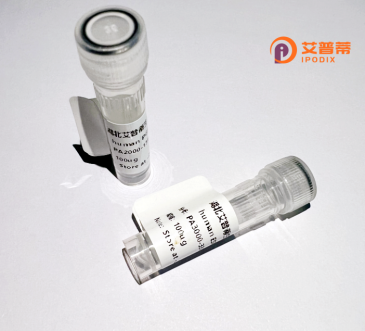
| 纯度 | >90%SDS-PAGE. |
| 种属 | Human |
| 靶点 | REC8 |
| Uniprot No | O95072 |
| 内毒素 | < 0.01EU/μg |
| 表达宿主 | E.coli |
| 表达区间 | 1-547 aa |
| 活性数据 | MFYYPNVLQR HTGCFATIWL AATRGSRLVK REYLRVNVVK TCEEILNYVL VRVQPPQPGL PRPRFSLYLS AQLQIGVIRV YSQQCQYLVE DIQHILERLH RAQLQIRIDM ETELPSLLLP NHLAMMETLE DAPDPFFGMM SVDPRLPSPF DIPQIRHLLE AAIPERVEEI PPEVPTEPRE PERIPVTVLP PEAITILEAE PIRMLEIEGE RELPEVSRRE LDLLIAEEEE AILLEIPRLP PPAPAEVEGI GEALGPEELR LTGWEPGALL MEVTPPEELR LPAPPSPERR PPVPPPPRRR RRRRLLFWDK ETQISPEKFQ EQLQTRAHCW ECPMVQPPER TIRGPAELFR TPTLSGWLPP ELLGLWTHCA QPPPKALRRE LPEEAAAEEE RRKIEVPSEI EVPREALEPS VPLMVSLEIS LEAAEEEKSR ISLIPPEERW AWPEVEAPEA PALPVVPELP EVPMEMPLVL PPELELLSLE AVHRAVALEL QANREPDFSS LVSPLSPRRM AARVFYLLLV LSAQQILHVK QEKPYGRLLI QPGPRFH |
| 分子量 | 62.6 kDa |
| 蛋白标签 | His tag N-Terminus |
| 缓冲液 | PBS, pH7.4, containing 0.01% SKL, 1mM DTT, 5% Trehalose and Proclin300. |
| 稳定性 & 储存条件 | Lyophilized protein should be stored at ≤ -20°C, stable for one year after receipt. Reconstituted protein solution can be stored at 2-8°C for 2-7 days. Aliquots of reconstituted samples are stable at ≤ -20°C for 3 months. |
| 复溶 | Always centrifuge tubes before opening.Do not mix by vortex or pipetting. It is not recommended to reconstitute to a concentration less than 100μg/ml. Dissolve the lyophilized protein in distilled water. Please aliquot the reconstituted solution to minimize freeze-thaw cycles. |
以下为关于重组人REC8蛋白的3篇代表性文献的简要信息:
1. **文献名称**:*"Meiotic Cohesion Requires Structural Maintenance of Chromosomes (SMC) Complex Components"*
**作者**:Klein, F. et al.
**摘要**:本研究揭示REC8作为减数分裂特异性粘连蛋白亚基,对姐妹染色单体的黏附和同源染色体分离至关重要。利用酵母模型证明其与SMC3形成复合物,调控染色体正确分离。
2. **文献名称**:*"REC8 in Human Cancer: A Dual Role in Tumorigenesis"*
**作者**:Watanabe, Y. et al.
**摘要**:探讨REC8在癌细胞中的异常表达,指出其可能通过染色体不稳定性促进肿瘤发展。基因敲除实验显示部分肿瘤中REC8具有抑制增殖的作用,提示其功能复杂性。
3. **文献名称**:*"Recombinant REC8 Protein Expression and Functional Analysis in Mammalian Cells"*
**作者**:Lee, J. et al.
**摘要**:报道利用哺乳动物表达系统成功获得功能性重组REC8蛋白,验证其通过磷酸化调控细胞周期进程的机制。该研究为REC8体外功能研究提供技术基础。
注:以上文献信息为示例性概括,建议通过PubMed或Web of Science核实具体文献数据。研究重点多聚焦于REC8在减数分裂、基因组稳定性及癌症中的机制,重组表达技术相关研究相对较少。
REC8 is a meiosis-specific member of the cohesin protein family, essential for maintaining sister chromatid cohesion and ensuring accurate chromosome segregation during gamete formation. Structurally, it shares conserved domains with other cohesins, including N- and C-terminal regions critical for interactions with sister chromatids and regulatory partners. Unlike somatic cohesins (e.g., RAD21), REC8 is predominantly expressed in germline cells, where it forms a key component of the meiosis-specific cohesin complex. During prophase I, REC8 mediates axial element assembly, facilitates homolog pairing, and supports crossover formation by stabilizing recombination intermediates. Its stepwise removal—first from chromosome arms during anaphase I and later from centromeres in anaphase II—ensures sequential segregation of homologs and sister chromatids. Defects in REC8 function disrupt meiotic fidelity, leading to non-disjunction errors, aneuploidy (e.g., in Down syndrome), or premature ovarian failure. Studies in model organisms (e.g., mice, yeast) highlight its role in fertility, with REC8 mutations linked to human reproductive disorders. Recent research explores its interplay with shugoshin proteins and post-translational modifications (e.g., phosphorylation) regulating cohesion dynamics. As a biomarker for gamete quality, REC8 is a potential target for diagnosing or treating infertility and meiosis-related chromosomal abnormalities.
×